
Angling in Yellowstone National Park
Encyclopedia
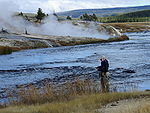
Angling
Angling is a method of fishing by means of an "angle" . The hook is usually attached to a fishing line and the line is often attached to a fishing rod. Fishing rods are usually fitted with a fishing reel that functions as a mechanism for storing, retrieving and paying out the line. The hook itself...
in Yellowstone National Park
Yellowstone National Park
Yellowstone National Park, established by the U.S. Congress and signed into law by President Ulysses S. Grant on March 1, 1872, is a national park located primarily in the U.S. state of Wyoming, although it also extends into Montana and Idaho...
is a major reason many visitors come to the park each year and since it was created in 1872, the park has drawn anglers from around the world to fish its waters. In 2006, over 50,000 park fishing permits were issued to visitors. The park contains hundreds of miles of accessible, high-quality trout rivers containing wild trout populations—over 200 creeks, streams and rivers are fishable. There are 45 fishable lakes and several large lakes are easily accessible to visitors. Additionally, the park's remote sections provide anglers ample opportunity to visit rivers, streams, creeks and lakes that receive little angling pressure. With the exception of one specially designated drainage, all the park's waters are restricted to artificial lures
Fishing lure
A fishing lure is an object attached to the end of a fishing line which is designed to resemble and move like the prey of a fish. The purpose of the lure is to use movement, vibration, and colour to catch the fish's attention so it bites the hook...
and fly fishing
Fly fishing
Fly fishing is an angling method in which an artificial 'fly' is used to catch fish. The fly is cast using a fly rod, reel, and specialized weighted line. Casting a nearly weightless fly or 'lure' requires casting techniques significantly different from other forms of casting...
. The Madison, Firehole and a section of the Gibbon rivers are restricted to fly fishing only.
Anglers visiting the park to fish will encounter cutthroat
Cutthroat trout
The cutthroat trout is a species of freshwater fish in the salmon family of order Salmoniformes. It is one of the many fish species colloquially known as trout...
, rainbow
Rainbow trout
The rainbow trout is a species of salmonid native to tributaries of the Pacific Ocean in Asia and North America. The steelhead is a sea run rainbow trout usually returning to freshwater to spawn after 2 to 3 years at sea. In other words, rainbow trout and steelhead trout are the same species....
, brown
Brown trout
The brown trout and the sea trout are fish of the same species....
, brook
Brook trout
The brook trout, Salvelinus fontinalis, is a species of fish in the salmon family of order Salmoniformes. In many parts of its range, it is known as the speckled trout or squaretail. A potamodromous population in Lake Superior are known as coaster trout or, simply, as coasters...
and lake trout
Lake trout
Lake trout is a freshwater char living mainly in lakes in northern North America. Other names for it include mackinaw, lake char , touladi, togue, and grey trout. In Lake Superior, they can also be variously known as siscowet, paperbellies and leans...
, mountain whitefish
Mountain whitefish
The mountain whitefish is one of the most widely distributed salmonid fish of western North America. It is found from the Mackenzie River drainage in Northwest Territory, Canada south through western Canada and the northwestern USA in the Pacific, Hudson Bay and upper Missouri River basins to the...
and arctic grayling
Arctic grayling
Arctic grayling is a species of freshwater fish in the salmon family of order Salmoniformes. It comprises five subspecies native to the Nearctic and Palearctic ecozones. T. a. arcticus is widespread throughout the Arctic and Pacific drainages in Canada, Alaska, and Siberia, as well as the upper...
. The park's fishing season runs from the Saturday in May associated with Memorial Day
Memorial Day
Memorial Day is a United States federal holiday observed on the last Monday of May. Formerly known as Decoration Day, it originated after the American Civil War to commemorate the fallen Union soldiers of the Civil War...
to the first Sunday in November each year. The National Park Service
National Park Service
The National Park Service is the U.S. federal agency that manages all national parks, many national monuments, and other conservation and historical properties with various title designations...
regulates angling in the park and classifies different fish available to the angler as either Native or Non-Native species. Any native species—cutthroat trout, grayling and whitefish—caught must be immediately released unharmed. Non-natives—rainbow, brown, brook and lake trout have different bag limits depending on the waters fished. Some non-natives are also subject to catch and release
Catch and release
Catch and release is a practice within recreational fishing intended as a technique of conservation. After capture, the fish are unhooked and returned to the water before experiencing serious exhaustion or injury...
regulations and all lake trout caught in Yellowstone Lake or river must be killed. All hooks
Fish hook
A fish hook is a device for catching fish either by impaling them in the mouth or, more rarely, by snagging the body of the fish. Fish hooks have been employed for centuries by fishermen to catch fresh and saltwater fish. In 2005, the fish hook was chosen by Forbes as one of the top twenty tools...
used in the park must be barbless or have their barbs pinched down. Many specific waters or sections of waters are closed either permanently for either safety reasons, wildlife management
Wildlife management
Wildlife management attempts to balance the needs of wildlife with the needs of people using the best available science. Wildlife management can include game keeping, wildlife conservation and pest control...
or to protect thermal features. The National Park Service may also enact emergency closures and restrictions because of low water, high temperatures or fires.
Anglers should always be familiar with the most current regulations, restrictions and closures. A Yellowstone National Park fishing permit is required to fish in the park. State licenses are not required.
Angling supplies are available in the park's concession stores and in the towns associated with major entrances to the park—West Yellowstone, Montana
West Yellowstone, Montana
West Yellowstone is a town in Gallatin County, Montana, adjacent to Yellowstone National Park. The population was 1,177 at the 2000 census. The town is served by Yellowstone Airport...
; Gardiner, Montana
Gardiner, Montana
Gardiner is a census-designated place in Park County, Montana, United States, along the 45th parallel. The population was 851 at the 2000 census....
; Jackson, Wyoming
Jackson, Wyoming
Jackson is a town located in the Jackson Hole valley of Teton County, Wyoming, United States. The population was 8,647 at the 2000 census. It is the county seat of Teton County....
; Cody, Wyoming
Cody, Wyoming
Cody is a city in Park County, Wyoming, United States. It is named after William Frederick Cody, primarily known as Buffalo Bill, from William Cody's part in the creation of the original town. The population was 9,520 at the 2010 census...
and Cooke City, Montana
History
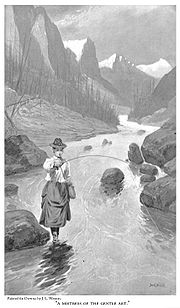
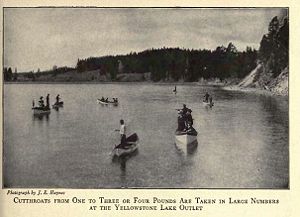
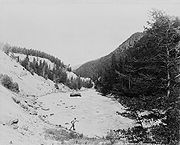
Probably the most dramatic example of this is the Firehole River
Firehole River
The Firehole River is one of two major tributaries of the Madison River. It flows north approximately from its source in Madison Lake on the Continental Divide to join the Gibbon River at Madison Junction in Yellowstone National Park...
above Firehole Falls. When the Washburn-Langford-Doane Expedition
Washburn-Langford-Doane Expedition
The Washburn Expedition of 1870, explored the region of northwestern Wyoming that a couple years later became Yellowstone National Park. Led by Henry Washburn, Nathaniel P. Langford and under U.S. Army escort led by Lt. Gustavus C...
camped on the shores of the upper Firehole in the fall of 1870, the river was barren of trout. The same was true of the Gibbon River
Gibbon River
The Gibbon River is a river in Yellowstone National Park, in Wyoming, the United States. It rises in the center of the park at Grebe Lake. It flows for a short distance into Wolf Lake. Below Wolf Lake, the river flows through Virginia Cascades into the Norris valley. It flows near the Norris...
and Gibbon Falls
Gibbon Falls
Gibbon Falls is a waterfall on the Gibbon River in southwestern Yellowstone National Park in the United States. Gibbon Falls has a drop of approximately...
. Today, the upper Firehole is one of the premier angling destinations in North America.
One of the earliest accounts of trout fishing in the park is from Mary Trowbridge Townsend's 1897 article in Outing Magazine A Woman's Trout Fishing in Yellowstone Park in which she talks about catching the Von Behr trout in the Fire Hole [sic] river.
In the early days of government stocking operations all types of attempts were made to introduce desirable species for the angler. In the case of Yellowstone, both landlocked atlantic salmon
Atlantic salmon
The Atlantic salmon is a species of fish in the family Salmonidae, which is found in the northern Atlantic Ocean and in rivers that flow into the north Atlantic and the north Pacific....
and largemouth bass
Largemouth bass
The largemouth bass is a species of black bass in the sunfish family native to North America . It is also known as widemouth bass, bigmouth, black bass, bucketmouth, Potter's fish, Florida bass, Florida largemouth, green bass, green trout, linesides, Oswego bass, southern largemouth...
were introduced but never established themselves in the park. Yellow perch were illegally introduced, established themselves in a few lakes and were later poisoned out. By the early 20th Century, a number of hatcheries were established in the park by the U.S. Bureau of Fisheries. These hatcheries not only produced stocks for the park, but also took advantage of the great spawning stock of Cutthroat trout to supply eggs to hatcheries around the U.S. Between 1901 and 1953, 818 million trout eggs were exported from the park to hatcheries throughout the U.S.
The hatcheries and stocking operations had both positive and negative impacts on the quality of angling in Yellowstone National Park in the first half of the 20th Century. Many native populations were displaced by non-natives, but there was quality brown and rainbow trout fishing in the Firehole, Madison and Gibbon river drainages. Stocking and hatchery operations had had an overall negative impact on the Yellowstone cutthroat and Westslope cutthroat populations and in 1953 the National Park Service began closing the hatcheries and stopping stocking operations. The last fish stocked for the benefit of anglers was in 1955 after some 310 million fish had been released in park waters since 1889.
The regulation of anglers in the park also evolved significantly since the park's creation. Original angling was a subsistence affair to fill a camp's larder and feed visitors to the park. Although fishing methods were limited to hook and line early in the park's history, there were no limits
Bag limits
A bag limit is a law imposed on hunters and fishermen restricting the number of animals within a specific species or group of species they may kill and keep. Size limits and hunting seasons sometimes accompany bag limits which place restrictions on the size of those animals and the time of year...
. In the 1920s, a daily limit of 20 fish was set. This was reduced to 10, then 5 and then 3 in 1954. Limits have fluctuated based on waters and species ever since then. Until 1969, bait could be used in most waters. In 1950, the Madison and Firehole rivers were designated as "Fly Fishing Only." The lower Gibbon river was given that designation in 1968. In 1970, regulation turned to minimum size limits for cutthroat trout and there began an era where the emphasis of regulation became the protection of native species. Angling permits were free in the park until 1994 when a $10 fee was charged for a 7 day permit.
The Outfitters and Writers
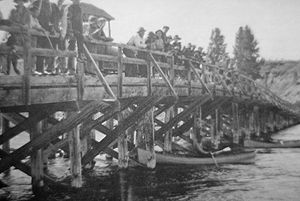
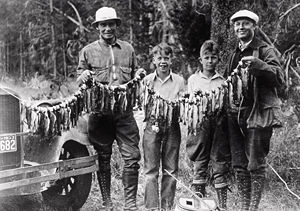
In 1936 and 1937 a British businessman and fly fisherman who emigrated to New York in 1930 by the name of Howard Back visited the park and compiled the first real assessment of the various waters and what the fly fisherman could expect from them. In his The Waters of the Yellowstone with Rod and Fly (1938), Back described his fishing experiences on what he called the Four Rivers which include the Madison, Firehole and Gibbon rivers, as well as the Yellowstone river. Prior to Back's work, the only available serious reference for anglers was a 1921 Bureau of Fisheries publication entitled: The Fishes of the Yellowstone National Park—With Description of Park Waters and Notes on Fishing, a publication that Back encouraged all prospective anglers visiting Yellowstone to read,
In 1938, at the same time Back was publishing his work, Dan Bailey
Dan Bailey
Dan Bailey was a fly-shop owner, innovative fly developer and staunch Western conservationist. Born on a farm near Russellville, Kentucky, Bailey is best known for the fly shop he established in Livingston, Montana in 1938...
, another eastern angler was opening Dan Bailey's fly shop in Livingston, Montana
Livingston, Montana
-Geography:Livingston is located at , at an altitude of 4.501 feet .According to the United States Census Bureau, the city has a total area of , of which, of it is land and 0.38% is waters.-Climate:-Demographics:...
55 miles (88.5 km) north of the Gardiner park entrance. Although Dan Bailey guided and serviced fly fisherman throughout South Central Montana, much of his business was guiding and outfitting fishermen in Yellowstone National Park. Dan Bailey's Fly Shop is still in business today servicing anglers visiting Yellowstone.
Although West Yellowstone had become the major tourist entrance to the park since the Oregon Short Line began operations in 1907, the establishment of serious fly fishing outfitters in West Yellowstone didn't occur until the mid 1930s when Don Martinez, the fly tier who popularized the woolly worm
Woolly Worm (imitation)
The Woolly Worm is an artificial fly commonly categorized as a wet fly or nymph and is fished under the water surface. It is a popular pattern for freshwater game fish and was a very popular fly in the 1950s – 1970s in the west. Charles Brooks in Nymph Fishing for Larger Trout recommends the...
opened a seasonal, one-room fly shop. In 1947, a fly fisherman and tier who worked for Martinez, Pat Barnes opened a fulltime fly shop, which today is Bob Jacklin's Fly Shop on the corner of Yellowstone and Canyon streets. The real landmark came in 1952 when a young man from Manhattan, Montana
Manhattan, Montana
Manhattan is a town in Gallatin County, Montana, United States. The population was 1,396 at the 2000 census. It is part of the 'Bozeman Micropolitan Statistical Area'.-Geography:Manhattan is located at ....
by the name of Bud Lilly opened Bud Lilly's Trout Shop on the corner of Madison and Canyon Streets. Lilly guided anglers, taught fly casting and outfitted anglers in Yellowstone for 35 years and did more than anyone else in the 1950–70s to promote fly fishing and fisheries conservation in Yellowstone throughout North America. Many of the great post-WWII era anglers first came to Yellowstone and the West because of Bud Lilly's Trout Shop and his writings.
Gardiner, Montana although not the size or draw of West Yellowstone got its own local fly fishing legend in 1953 when Merton J. Parks opened Parks' Fly Shop
Parks' Fly Shop
Parks Fly Shop is a fly shop and licensed fly fishing outfitter in Gardiner, Montana. In business since 1953, the shop located at 202 2nd Street between Main and Stone is the oldest business in Gardiner under continuous family ownership.-History:...
. Still operating today and run by his son, Richard Parks, Parks' Fly Shop and its guides have contributed significantly to the angling history of the park with the publication of Fishing Yellowstone National Park—An Angler's Complete Guide to More than 100 streams, rivers and lakes (1998).
Many well-known angling authors have written about their experiences in Yellowstone National Park. Howard Back was the first, but many influential anglers used Yellowstone as a backdrop for their angling stories, adventures and technical work.
Ray Bergman, the well-known angling editor of Outdoor Life
Outdoor Life
Outdoor Life is an outdoors magazine about hunting, fishing, survival and camping. It is a sister magazine of Field & Stream. Together with Sports Afield, they are considered the Big Three of American outdoor publishing. Outdoor Life launched in Denver, Colorado in January 1898. Founder and...
magazine was a fan of the Firehole river and gave it many pages of coverage in his classic work Trout (1938, 1952). Here's a typical passage describing his fishing experiences in the Midway Geyser Basin section of the Firehole:
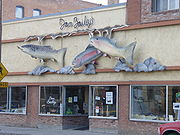
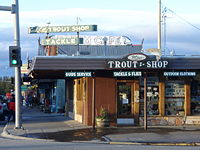
One cannot own a river or even part of it, except in one's heart. But if affection, pride, knowledge, and experience for and about a river counts for anything, the part of the Madison River in Yellowstone Park belongs to me. It also belongs to 220 million other Americans, but few know and love it as I do.
Fly Fishing in Yellowstone
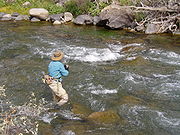
Fly fishing
Fly fishing is an angling method in which an artificial 'fly' is used to catch fish. The fly is cast using a fly rod, reel, and specialized weighted line. Casting a nearly weightless fly or 'lure' requires casting techniques significantly different from other forms of casting...
destination. Although artificial lures are allowed in some waters, most anglers, especially in the rivers and streams are fly fisherman. The accessible, insect rich rivers and streams provide reliable hatches and allow both novice and accomplished anglers alike a wide variety of opportunities for both technical and easy dry fly, wet fly, nymph or streamer fly fishing. There are nearly 50 outfitters in Montana, Wyoming, and Idaho licensed to provide guided fly fishing experiences in the park and operate fly shops outside the park.
| Major hatches and typical patterns used,,,,. | |
|---|---|
| Hatch | Typical Patterns Artificial fly An artificial fly or fly lure is a type of fishing lure, usually used in the sport of fly fishing . In general, artificial flies are the bait which fly fishers present to their target species of fish while fly fishing... |
| Mayflies Mayfly Mayflies are insects which belong to the Order Ephemeroptera . They have been placed into an ancient group of insects termed the Palaeoptera, which also contains dragonflies and damselflies... |
|
|
Pheasant Tail Nymph The Pheasant Tail is a popular nymph imitation used when fly fishing. It is used to mimic a large variety of creatures that many fish including Trout feed upon... |
| Caddisflies Trichoptera The caddisflies are an order, Trichoptera, of insects with approximately 12,000 described species. Also called sedge-flies or rail-flies, they are small moth-like insects having two pairs of hairy membranous wings... |
|
|
|
Partridge and Orange The Partridge and Orange is an Artificial fly commonly categorized as a wet fly or soft hackle and is fished under the water surface. The fly is a well known fly with its roots set firmly in English angling history. It is an impressionistic pattern fished successfully during caddis hatches and... |
| Stoneflies Plecoptera Plecoptera are an order of insects, commonly known as stoneflies. There are some 3,500 described species worldwide, with new species still being discovered. Stoneflies are found worldwide, except Antarctica... |
|
|
Pteronarcyidae Pteronarcyidae, also known as giant stoneflies or salmonflies, is a family of the order Plecoptera.- Natural history :There are two genera of Pteronarcyidae; Pteronarcys is found in all of North America, while Pteronarcella is found only in the west. The two genera comprise 10 distinct species, two... (Salmon Fly) |
|
| Terrestrial Terrestrial animal Terrestrial animals are animals that live predominantly or entirely on land , as compared with aquatic animals, which live predominantly or entirely in the water , or amphibians, which rely on a combination of aquatic and terrestrial habitats... s |
|
|
Grasshopper The grasshopper is an insect of the suborder Caelifera in the order Orthoptera. To distinguish it from bush crickets or katydids, it is sometimes referred to as the short-horned grasshopper... Annelid The annelids , formally called Annelida , are a large phylum of segmented worms, with over 17,000 modern species including ragworms, earthworms and leeches... |
|
| Baitfish Bait fish Bait fish are small fish caught for use as bait to attract large predatory fish, particularly game fish. Species used are typically those that are common and breed rapidly, making them easy to catch and in regular supply. Examples of marine bait fish are anchovies, halfbeaks such as ballyhoo, and... |
|
|
Cottus (genus) Cottus is a genus of the sculpin family Cottidae. It is often referred to as the "freshwater sculpins", as the principal genus of sculpins to be found in fresh water.They are mostly small fish, rarely reaching more than 15 cm in length.-Species:... Rhinichthys Rhinichthys, the riffle daces, is a genus of freshwater fish in the carp family of the order Cypriniformes. The type species is Rhinichthys atratulus, the blacknose dace. Rhinichthys species range throughout North America.... Leuciscus Leuciscus is a genus of fish belonging to the family Cyprinidae. They are commonly called Eurasian daces; familiar species include the Common Dace and Ide. The genus is widespread form Europe to Siberia.... Gila (genus) Gila is a genus of fish belonging to the family Cyprinidae, native to North America and Central America. Species of Gila are collectively referred to as western chubs. The chiselmouth is a close relative... |
Muddler Minnow The Muddler Minnow is a popular and versatile artificial fly of the streamer type used in fly fishing and fly tying.-History:The Muddler Minnow was spawned, so to speak, by Don Gapen of Anoka, Minnesota in 1937, to imitate the slimy sculpin. Gapen developed this fly to catch Nipigon strain brook... Woolly Bugger The Woolly Bugger is an artificial fly commonly categorized as a wet fly or streamer and is fished under the water surface. It is a popular and widely used pattern for both freshwater and saltwater game fish and is generally listed as one of the top patterns to have in any fly box... |
Major Rivers
| Image | Description |
|---|---|
| Gallatin River 44°51′29"N 110°53′01"W | |
 |
The Gallatin River Gallatin River The Gallatin River is a tributary of the Missouri River, approximately 120 mi , in the U.S. states of Wyoming and Montana... is a headwater tributary of the Missouri River Missouri River The Missouri River flows through the central United States, and is a tributary of the Mississippi River. It is the longest river in North America and drains the third largest area, though only the thirteenth largest by discharge. The Missouri's watershed encompasses most of the American Great... , approximately 120 mi (193 km long), in the U.S. states of Wyoming and Montana. It is one of three rivers, along with the Jefferson and Madison, that converge near Three Forks, Montana, to form the Missouri. It rises in the northwest corner of the park and flows 23 miles (37 km) north through the park into Montana. The Gallatin contains rainbow trout, brown trout and mountain whitefish. Access to the lower 11 miles (17.7 km) of the Gallatin River in the park is excellent along Highway 191. The Gallatin in the park is small and twists and turns with numerous undercut banks and lots of runs, riffles and holes. The water is very clear and cold and midsummer after runoff is generally the best fishing. Fishing pressure on the Gallatin River is moderate. The Gallatin River in the valley section has excellent fly fishing for both rainbow and brown trout. Average rainbow size is 12 inches (304.8 mm). Brown trout average between 12–14 inches, although larger fish are often caught. Five brown and/or rainbow trout may be harvested daily. All whitefish and cutthroat trout caught must be released. |
| Madison River 44°38′32"N 110°51′56"W | |
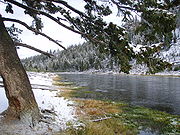 |
The Madison River Madison River The Madison River is a headwater tributary of the Missouri River, approximately 183 miles long, in Wyoming and Montana. Its confluence with the Jefferson and Gallatin rivers near Three Forks, Montana form the Missouri River.... is a headwater tributary of the Missouri River, approximately 183 miles (295 km) long, in the U.S. states of Wyoming and Montana. Its confluence with the Jefferson and Gallatin rivers near Three Forks, Montana form the Missouri River. The Madison rises in Park County in northwestern Wyoming at the confluence of the Firehole and Gibbon rivers, a location known as Madison Junction in Yellowstone National Park. It flows west then north through the mountains of southwestern Montana to join the Jefferson and Gallatin rivers at Three Forks. The 19 miles (30.6 km) of the Madison in the park, although easily accessible, is not suited for beginners and offers technical dry fly and nymph fishing for rainbow and brown trout averaging from ten to fourteen inches (356 mm) , with an occasional 20-incher. Most of the river inside the park resembles a large spring creek and has been called the world's largest chalkstream. The Madison is an early summer and fall river and offers poor fishing in midsummer because of high temperatures contributed by the Firehole. Fishing in the fall is excellent when significant numbers of brown and rainbow trout enter the river from Hebgen Lake. These are usually taken with large streamer patterns. Many pools and runs on the Madison have angler-given names reminiscent of eastern trout stream and British salmon rivers—The Barns, Beaver Meadows, Grasshopper Bank, Cable Car Run and Baker's Hole. The Madison River is fly fishing only in Yellowstone National Park and all fishing is catch and release. |
| Firehole River 44°20′37"N 110°52′43"W | |
 |
The Firehole River Firehole River The Firehole River is one of two major tributaries of the Madison River. It flows north approximately from its source in Madison Lake on the Continental Divide to join the Gibbon River at Madison Junction in Yellowstone National Park... is a famous and storied destination for serious fly fisherman and runs completely within the park boundary. It is the major tributary of the Madison river providing some 70% of the volume. When it was discovered in the 1830s by American explorers, the Firehole was barren of trout above what is now called Firehole Falls. Brook trout were first introduced to the upper Firehole in 1889, while brown trout, the river's most plentiful trout today, was first stocked in 1890. Rainbow trout Rainbow trout The rainbow trout is a species of salmonid native to tributaries of the Pacific Ocean in Asia and North America. The steelhead is a sea run rainbow trout usually returning to freshwater to spawn after 2 to 3 years at sea. In other words, rainbow trout and steelhead trout are the same species.... were not introduced until 1923. Mountain whitefish are native to the Firehole below Firehole Falls. The Firehole is one of those rivers with angler-given names to various famous and productive sections such a Muleshoe Bend and the Broads. The Firehole has been called the "strangest trout stream on Earth." This spring-fed river flows through the most active geyser basins in Yellowstone Park, so the angler is often fishing against a backdrop of steam rising from a gurgling hot spring. The Firehole provides excellent dry fly fishing from opening day until it warms too much from geysers by the end of June. For the most part the Firehole is an easily accessible, slow moving meadow stream that demands careful presentations and imitative flies for the prolific caddis and mayfly hatches. Fall fishing in September and October is again excellent as the river cools. The Firehole River is fly fishing only and rainbow and brown trout are catch and release only. Five brook trout may be harvested daily. |
| Gibbon River 44°45′10"N 110°33′57"W | |
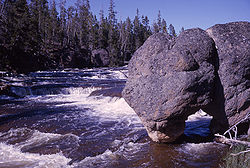 |
The Gibbon River Gibbon River The Gibbon River is a river in Yellowstone National Park, in Wyoming, the United States. It rises in the center of the park at Grebe Lake. It flows for a short distance into Wolf Lake. Below Wolf Lake, the river flows through Virginia Cascades into the Norris valley. It flows near the Norris... begins in the center of Yellowstone National Park, at Grebe Lake. It flows for a short distance into Wolf Lake. Below Wolf Lake, the Gibbon River twists and turns through beautiful and varied country before its confluence with the Firehole River to form the Madison River. The upper section of Gibbon River has very difficult access being choked with thick forests and lots of downed timber. The fish, consisting of brook trout, rainbow trout and grayling are all on the small side, rarely exceeding 10 inches (254 mm). Below Gibbon Falls access is excellent and the river has a healthly mix of rainbow and brown trout. The lower river receives a good run of spawning browns in the fall. The Gibbon River is fly fishing only and catch and release below Gibbon Falls. Above the falls, any grayling or cutthroat trout caught must be released. Five brook, rainbow and/or brown trout may be harvested daily in the waters above the falls. |
| Upper Yellowstone River 43°59′18"N 109°55′45"W | |
 |
The upper Yellowstone River Yellowstone River The Yellowstone River is a tributary of the Missouri River, approximately long, in the western United States. Considered the principal tributary of the upper Missouri, the river and its tributaries drain a wide area stretching from the Rocky Mountains in the vicinity of the Yellowstone National... rises in northwestern Wyoming near Younts Peak at the Continental Divide in southwestern Park County. It flows northward some 25 miles (40.2 km) through Yellowstone National Park and into draining Yellowstone Lake. The upper Yellowstone is a meandering, many-channeled stream with a clean gravel or sand-silt bottom. It lies in a broad valley, one to three miles (5 km) across, which is often marshy or boggy. This cutthroat fishery and area is as primitive and wild as it was 200 years ago and is one of the most difficult, time-consuming places in Yellowstone Park to get to and is considered one of the remotest places in the lower 48 states. Three days is about the minimum time required to visit and fish it. The fish are not much different is size and abundance than in the lower river. There is probably no trout stream anywhere in the forty-eight lower states that has been less affected by man than this one. All cutthroat trout caught must be released. |
| Lower Yellowstone River 44°37′21"N 110°25′36"W | |
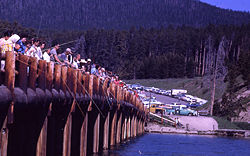 |
The lower Yellowstone river begins at the outlet of Yellowstone lake. After passing through Hayden meadows, it drops over the Upper and Lower Yellowstone Falls at the head of the Grand Canyon of the Yellowstone within the confines of the park. After passing through the Black Canyon of the Yellowstone downstream of the Grand Canyon, the river flows northward into Montana exiting the park at Gardiner. Inside Yellowstone National Park is some of the most gorgeous flat water fishing for pure Yellowstone cutthroats you'll experience anywhere. A portion of this stretch (through Hayden Valley) is closed all year, but the rest is easily accessible and easily wadable. No floating is allowed. Wonderful hatches occur just after the opener, on July 15. Pale Morning Duns, Green Drakes, Gray Drakes, caddis and even salmonflies are found at that time. The river can be crowded at popular access points like Buffalo Ford, but if you hike a bit, there are many good spots where you can get away from the crowds. The canyon reaches inside Yellowstone National Park are accessible only by hiking or horseback. This is some terrific fishing at times, especially during the salmonfly hatch in early to mid-July. Good access points are at Canyon Village, Tower, and Gardiner with a couple of other trailhead access points in between. If you are in good shape and like to combine some hiking and fishing, this is great water to explore. The scenery is magnificent. The river here is usually quite swift, with sheer canyon walls in spots. Wading can be dangerous in these sections, so be careful. The payoff are big fat cutthroats and some very nice rainbows. Below Knowles Falls, about four miles (6 km) upstream from Gardiner, you'll find browns and whitefish in addition to the rainbows and cutthroat trout. All whitefish and cutthroat trout caught in the Yellowstone river must be released. Five rainbow and/or brown trout may be harvested from the lower Yellowstone river. |
| Gardner River 44°57′15"N 110°52′03"W | |
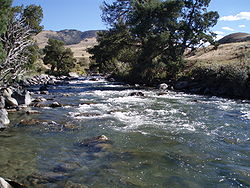 |
The Gardner River Gardner River The Gardner River is a tributary of the Yellowstone River, approximately long, in northwestern Wyoming and south central Montana in the United States. The entire river is located within Yellowstone National Park... is a tributary of the Yellowstone river and enters the Yellowstone at the park boundary in the town of Gardiner, Montana Gardiner, Montana Gardiner is a census-designated place in Park County, Montana, United States, along the 45th parallel. The population was 851 at the 2000 census.... . The Gardner can be divided into three sections. The upper river consists of meadows reminiscent of Slough Creek or Soda Butte, but contains plentiful brook trout instead of cutthroats. The middle Gardner is fast canyon water with long runs of pocket water interspersed with pools and runs. The lower Gardiner from Bolling River to the confluence with the Yellowstone is similar but with easier access from the Mammoth–Gardiner road. The middle and lower sections contain good populations of rainbow, cutthroat and brown trout. In the late fall, the Gardner is known for its annual run of spawning browns which travel up the river from the Yellowstone. The Gardner river's pocket water, bouldered pools and runs offer good dry fly and nymph fishing, especially in the late summer and fall. Although high runoff can impair early summer fishing, the Gardner does get a reliable hatch of large stoneflies in June and July. All whitefish and cutthroat trout caught in the Gardner river must be released. Five brook, brown and/or rainbow trout may be harvested daily. |
| Lamar River 44°42′19"N 109°49′33"W | |
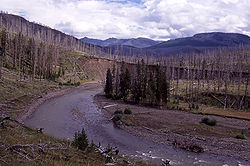 |
The Lamar River Lamar River The Lamar River is a tributary of the Yellowstone River, approximately 40 miles long, in northwestern Wyoming in the United States. The river is located entirely within Yellowstone National Park.-History:... is a tributary of the Yellowstone River, approximately 40 miles (48 km) long, in northwestern Wyoming in the United States. The river is located entirely within the park. It rises in the Absaroka Range, on the eastern edge of the park, and flows northwest through the northeast corner of the park. It is joined by many tributary streams, including Soda Butte Creek and Slough Creek and joins the Yellowstone near Tower Junction, just below the Grand Canyon of the Yellowstone. The river is very accessible and meanders through grassy meadows, with riffles, boulders, and undercut banks providing cover for mostly cutthroat trout. More rainbows are found as the river pours through a rocky canyon just before it joins the Yellowstone. The Lamar offers good dry fly fishing with heavy hatches of caddis, pale morning duns, and large Green Drake in July. Terrestrials are prominent in late summer. All cutthroat trout caught in the Lamar river must be released. Five rainbow trout may be harvested daily. |
| Slough Creek 45°12′30"N 110°07′18"W | |
| Slough Creek Slough Creek (Wyoming) Slough Creek is a tributary of the Lamar River, approximately 25 mi long, in Montana and Wyoming in the United States.-History:... is a tributary of the Lamar River, approximately 25 mi (40 km) long, in Montana and Wyoming in the United States. It rises in southern Montana, in the Absaroka–Beartooth Wilderness in the Beartooth Mountains, and flows southwest, into the park and into Wyoming, then into the Lamar River. Slough Creek is one of the most popular fishing areas in Yellowstone Park. The access is relatively easy and the cutthroat fishing is some of the best in the world. The lower meadows of Slough Creek, below the campground, are easily accessible from parking areas between the campground and the Cooke City road. There are rainbows in this lower water as well as cutthroats. The upper meadows of Slough are accessed from a trailhead near the campground. The first meadow is a 45 minute walk from the trailhead. The first meadow is the most popular since it's close and the fishing is excellent. Slough Creek's second meadow is about a 2 hour hike. Cutthroat trout in Slough offer good dry fly fishing with heavy hatches of caddis, pale morning duns, and large Green Drake in July. Terrestrials are prominent in late summer. All cutthroat trout caught in Slough creek must be released. Five rainbow trout may be harvested daily. |
|
| Soda Butte Creek 45°01′20"N 109°55′03"W | |
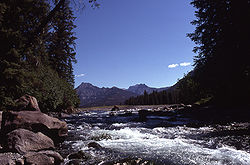 |
Soda Butte Creek Soda Butte Creek Soda Butte Creek is an approximately long major tributary of the Lamar River in Yellowstone National Park. It is named for an unusual geologic feature near its mouth. Soda Butte and the creek were named by A. Bart Henderson, a Cooke City miner, in 1870... is a major tributary of the Lamar River. Access is quite easy—the highway between Tower and the Northeast Entrance closely follows the river for almost the entire length. The fly fishing in Soda Butte Creek is excellent. Similar to the Lamar River, Soda Butte Creek can run high and muddy during spring run-off, an event that can last through late-July in some years. However, once Soda Butte Creek begins to clear, excellent fly fishing for rainbow and cutthroat trout can be found on the lower section of the river, generally defined as downstream from the Pebble Creek campground area. Average rainbow trout size runs around 12 inches (304.8 mm), with fish exceeding 16 inches (406.4 mm) not uncommon,. All cutthroat trout caught in Soda Butte Creek must be released. Five rainbow trout may be harvested daily. |
| Lewis River 44°21′19"N 110°39′54"W | |
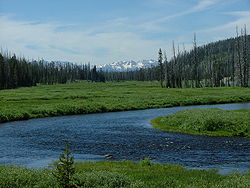 |
The Lewis River Lewis River (Wyoming) The Lewis River is an tributary of the Snake River. The entire course of the river is located within the boundaries of Yellowstone National Park in Wyoming. The river is named for Meriwether Lewis, commander of the Lewis and Clark Expedition.... begins at the southern end of Shoshone Lake and flows southerly approximately 4.5 miles (7.2 km) to Lewis Lake. This short stretch of the river known as the Lewis River Channel is the only portion of the river where boating is permitted. The river reemerges at the southern end of Lewis Lake and flows in a general southerly direction through a steep canyon roughly paralleling the south entrance road toward the south entrance of the park The Lewis River Channel is noted for its outstanding Fall fishing for large spawning Brown and Lake trout migrating out of Shoshone and Lewis lakes. The lower gradient sections below Lewis lake and as the river enters the Snake river provide good fishing for brown and brook trout. The steep canyon section is difficult to access and is typically not very productive fishing. All Cutthroat and Rainbow trout caught must be released. Brown and brook trout caught above Lewis Falls Lewis Falls The Lewis Falls are located on the Lewis River in Yellowstone National Park, Wyoming, United States. The falls drop approximately and are easily seen from the road, approximately halfway between the south entrance to the park and Grant Village.... may be harvested within limits. |
| Bechler River | |
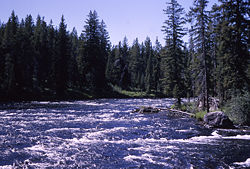 |
Bechler River Bechler River The Bechler River is a remote major river flowing southwest entirely within the confines of Yellowstone National Park to it confluence with the Fall River in the southwest section of the park. The river was named by Frank Bradley, a member of the 1872 Hayden Geological Survey for Gustavus R.... |
| Snake River 44°07′49"N 110°13′10"W | |
 |
The Snake River Snake River The Snake is a major river of the greater Pacific Northwest in the United States. At long, it is the largest tributary of the Columbia River, the largest North American river that empties into the Pacific Ocean... is formed by the confluence of three tiny headstreams on the southwest flank of Two Oceans Plateau in western Wyoming and Yellowstone National Park and flows west and south into Jackson Lake in Grand Teton National Park Grand Teton National Park Grand Teton National Park is a United States National Park located in northwestern Wyoming, U.S. The Park consists of approximately and includes the major peaks of the long Teton Range as well as most of the northern sections of the valley known as Jackson Hole. Only south of Yellowstone... . The entire course of the Snake in the park lies within Yellowstone backcountry except where it exits the park at the South Entrance station. The South Boundary trail which connects with the Snake River trail provides good access for anglers. The Snake fishes well for 12-14" Snake River fine-spotted cutthroat trout Snake River fine-spotted cutthroat trout The Snake River fine-spotted cutthroat trout is a form of the Yellowstone cutthroat trout subspecies. Sub-species designation has been proposed with a trinomial classification of Oncorhynchus clarki behnkei, but the sub-species is not formally recognized... and Whitefish. Spawning Brown trout from Jackson Lake Jackson Lake Jackson Lake is a lake located in north western Wyoming in Grand Teton National Park. The lake is natural, except for the top 33 feet , which is due to the construction of Jackson Lake Dam, built in 1911. This top level of the lake is utilized by farmers in Idaho for irrigation purposes... migrate into the river in the fall. |
Major lakes
| Image | Description |
|---|---|
| Yellowstone Lake 44°28′N 110°22′W | |
| Yellowstone Lake Yellowstone Lake Yellowstone Lake is the largest body of water in Yellowstone National Park, The lake is 7,732 feet above sea level and covers with 110 miles of shoreline. While the average depth of the lake is 139 feet its deepest spot is at least 390 feet... is the largest body of water in the park. The lake is 7732 feet (2,356.7 m) above sea level and covers 136 square miles (352.2 km²) with 110 miles (177 km) of shoreline. While the average depth of the lake is 139 feet (42.4 m), its deepest spot is at least 390 feet (118.9 m). Yellowstone Lake is the largest freshwater lake above 7000 feet (2,133.6 m) in North America. Historically, Yellowstone Lake has been a major fishing destination for its Cutthroat Trout which could be easily caught from shore with lures and flies. Today, Cutthroat Trout populations are declining as a result of the unauthorized introduction of Lake Trout Lake trout Lake trout is a freshwater char living mainly in lakes in northern North America. Other names for it include mackinaw, lake char , touladi, togue, and grey trout. In Lake Superior, they can also be variously known as siscowet, paperbellies and leans... into the lake. The lake generally opens for angling in mid June. All Cutthroat Trout caught must be released and all Lake Trout caught must be killed. |
|
| Heart Lake 44°16′04"N 110°29′20"W | |
 |
Heart Lake Heart Lake (Wyoming) Heart Lake el. is a large backcountry lake, nestled at the base of Mount Sheridan in Yellowstone National Park. Heart Lake is in the Snake River drainage and is drained by the Heart River.-History:... holds Cutthroat Trout Cutthroat trout The cutthroat trout is a species of freshwater fish in the salmon family of order Salmoniformes. It is one of the many fish species colloquially known as trout... , Lake Trout Lake trout Lake trout is a freshwater char living mainly in lakes in northern North America. Other names for it include mackinaw, lake char , touladi, togue, and grey trout. In Lake Superior, they can also be variously known as siscowet, paperbellies and leans... , and Mountain whitefish Mountain whitefish The mountain whitefish is one of the most widely distributed salmonid fish of western North America. It is found from the Mackenzie River drainage in Northwest Territory, Canada south through western Canada and the northwestern USA in the Pacific, Hudson Bay and upper Missouri River basins to the... . Lake Trout were introduced in the 1890s. Angling is restricted to fly fishing Fly fishing Fly fishing is an angling method in which an artificial 'fly' is used to catch fish. The fly is cast using a fly rod, reel, and specialized weighted line. Casting a nearly weightless fly or 'lure' requires casting techniques significantly different from other forms of casting... or artificial lures. All Cutthoat Trout and Whitefish must be released. There is no limit on the number of Lake Trout harvested. The park record Lake Trout, 42 lbs, was caught in Heart Lake. Heart Lake is 7.5 miles (12.1 km) from the south entrance road at Lewis Lake Lewis Lake (Wyoming) Lewis Lake is located in the U. S. state of Wyoming in the southern part of Yellowstone National Park, about southeast of Shoshone Lake, and approximately southwest of Yellowstone Lake. Lewis Lake and Shoshone Lake are both located a few miles northeast of the Pitchstone Plateau.The Lewis River... via the Heart Lake trail. Heart Lake can also be reached via the Trail Creek trail that traverses the southern shoreline of Yellowstone Lake Yellowstone Lake Yellowstone Lake is the largest body of water in Yellowstone National Park, The lake is 7,732 feet above sea level and covers with 110 miles of shoreline. While the average depth of the lake is 139 feet its deepest spot is at least 390 feet... or via the Heart River trail/Snake River trail from the park's southern border. Heart Lake is within the Heart Lake Bear Management Area and access to the area is closed between April 1 and June 1 annually. |
| Shoshone Lake 44°22′20"N 110°42′45"W | |
 |
Prior to 1890, Shoshone Lake Shoshone Lake Shoshone Lake is a backcountry lake with the area of elevated at in the southwest section of Yellowstone National Park, Wyoming, US. It lies at the headwaters of the Lewis River a tributary of the Snake River. The U.S... was barren of fish as Lewis Falls Lewis Falls The Lewis Falls are located on the Lewis River in Yellowstone National Park, Wyoming, United States. The falls drop approximately and are easily seen from the road, approximately halfway between the south entrance to the park and Grant Village.... on the Lewis River was a barrier to upstream migration. In 1890, fisheries personnel planted Lake Lake trout Lake trout is a freshwater char living mainly in lakes in northern North America. Other names for it include mackinaw, lake char , touladi, togue, and grey trout. In Lake Superior, they can also be variously known as siscowet, paperbellies and leans... and Brown trout Brown trout The brown trout and the sea trout are fish of the same species.... and created a popular fishery, especially for large Brown trout in the fall. The lake also contains the Utah chub Utah chub The Utah chub is a cyprinid fish native to western North America, where it is abundant in the upper Snake River and throughout the Lake Bonneville basin.... which was probably inadvertently introduced by bait anglers in the 1950s. Brook Trout Brook trout The brook trout, Salvelinus fontinalis, is a species of fish in the salmon family of order Salmoniformes. In many parts of its range, it is known as the speckled trout or squaretail. A potamodromous population in Lake Superior are known as coaster trout or, simply, as coasters... were planted in several tributary streams and are occasionally found in the lake. Angling is restricted to fly fishing Fly fishing Fly fishing is an angling method in which an artificial 'fly' is used to catch fish. The fly is cast using a fly rod, reel, and specialized weighted line. Casting a nearly weightless fly or 'lure' requires casting techniques significantly different from other forms of casting... or artificial lures. Boating on Shoshone Lake is restricted to hand-powered craft only, which means float tube Float tube A float tube, also known as a belly boat or kick boat, is a flotation device which anglers use to fish from. They were originally doughnut-shaped boats with an underwater seat in the "hole", but modern designs include a V-shape with pontoons on either side and the seat raised above the water... s, kayak Kayak A kayak is a small, relatively narrow, human-powered boat primarily designed to be manually propelled by means of a double blade paddle.The traditional kayak has a covered deck and one or more cockpits, each seating one paddler... s or canoes. The lake is accessible by water via Lewis Lake Lewis Lake -United States:*Lewis Lake: a lake in Sumter Township, McLeod County, Minnesota*Lewis Lake, Massachusetts: located in Winthrop, Massachusetts*Lewis Lake, Minnesota: an unincorporated community in Kanabec County, Minnesota... and the Lewis River channel. Several trails provide access to the western, northern and eastern shoreline of the lake. The Shoshone Lake trail connects the Upper Geyser Basin and the Lewis River channel while passing through the Shoshone Geyser Basin at the southwest end of the lake. The DeLacy Creek trail provides access to the northern and eastern shoreline via the Grand Loop Road Grand Loop Road Historic District The Grand Loop Road Historic District encompasses the primary road system in Yellowstone National Park. Much of the system was originally planned by Captain Hiram M. Chittenden of the US Army Corps of Engineers in the early days of the park, when it was under military administration... near Craig Pass Craig Pass Craig Pass , is a mountain pass located on the Continental Divide in Yellowstone National Park in Wyoming. The Grand Loop Road crosses the pass approximately east of Old Faithful Geyser.... . The Dogshead trail and Lewis River Channel trail provide access from the south entrance road near Lewis Lake Lewis Lake -United States:*Lewis Lake: a lake in Sumter Township, McLeod County, Minnesota*Lewis Lake, Massachusetts: located in Winthrop, Massachusetts*Lewis Lake, Minnesota: an unincorporated community in Kanabec County, Minnesota... . There are 20 backcountry campsites on Shoshone Lake. |
| Lewis Lake 44°18′16"N 110°37′46"W | |
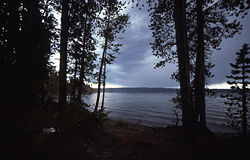 |
Lewis Lake Lewis Lake (Wyoming) Lewis Lake is located in the U. S. state of Wyoming in the southern part of Yellowstone National Park, about southeast of Shoshone Lake, and approximately southwest of Yellowstone Lake. Lewis Lake and Shoshone Lake are both located a few miles northeast of the Pitchstone Plateau.The Lewis River... is a popular brown and lake-trout fishery. The 2716 acres (11 km²) lake is 12 miles (19.3 km) north of the South Entrance, on the West Thumb–South Entrance Highway. This is the only lake besides Yellowstone Lake that allows motorized watercraft. This is also the only lake we know of where you can catch brook trout, browns, cutthroats, and lake trout on a dry fly. Most of the angling pressure is from spin fishers, but a few local fly anglers make the lake a regular stop, fishing the drop-off along the southwest shore with sinking lines and leech imitations. Fishing from a tube or a boat is more reliable than wade fishing the outlet. The best times to fish Lewis Lake are at ice-out in mid-June, warm summer evenings, and late October, when the spawning brown trout become aggressive. Streamers and leeches are effective in the early and late season with caddis the fly of choice on warm summer evenings. |
Minor Streams, Creeks and Lakes
| Image | Description |
|---|---|
| Grebe Lake 44°45′03"N 110°33′31"W | |
| Grebe Lake Grebe Lake Grebe Lake is a backcountry lake in Yellowstone National Park most noted for it population of Arctic Grayling. Grebe Lake comprises the headwaters of the Gibbon River. Grebe Lake is located approximately north of the Norris-Canyon section of the Grand Loop Road. The trail to the lake passes... is a 156 acre (0.63131016 km²) backcountry lake in Yellowstone National Park Yellowstone National Park Yellowstone National Park, established by the U.S. Congress and signed into law by President Ulysses S. Grant on March 1, 1872, is a national park located primarily in the U.S. state of Wyoming, although it also extends into Montana and Idaho... most noted for it population of Arctic Grayling Arctic grayling Arctic grayling is a species of freshwater fish in the salmon family of order Salmoniformes. It comprises five subspecies native to the Nearctic and Palearctic ecozones. T. a. arcticus is widespread throughout the Arctic and Pacific drainages in Canada, Alaska, and Siberia, as well as the upper... . Grebe Lake comprises the headwaters of the Gibbon River Gibbon River The Gibbon River is a river in Yellowstone National Park, in Wyoming, the United States. It rises in the center of the park at Grebe Lake. It flows for a short distance into Wolf Lake. Below Wolf Lake, the river flows through Virginia Cascades into the Norris valley. It flows near the Norris... . Grebe Lake is located approximately 3.1 miles (5 km) north of the Norris-Canyon section of the Grand Loop Road Grand Loop Road Historic District The Grand Loop Road Historic District encompasses the primary road system in Yellowstone National Park. Much of the system was originally planned by Captain Hiram M. Chittenden of the US Army Corps of Engineers in the early days of the park, when it was under military administration... . The trail to the lake passes through mostly level Lodgepole Pine Lodgepole Pine Lodgepole Pine, Pinus contorta, also known as Shore Pine, is a common tree in western North America. Like all pines, it is evergreen.-Subspecies:... forest and open meadows. There are four backcountry campsites located on the lake. |
|
| Trout Lake 44°54′02"N 110°07′50"W | |
| Trout Lake Trout Lake Trout Lake may refer to:*Trout Lake on the border of Polk County, Florida, and Highlands County, Florida* Trout Lake * Trout Lake in Ravalli County, Montana* Trout Lake in Sweet Grass County County, Montana... , formerly known as Fish Lake and Soda Butte Lake is a 12 acre (0.04856232 km²) popular backcountry lake for hikers and anglers in Yellowstone National Park Yellowstone National Park Yellowstone National Park, established by the U.S. Congress and signed into law by President Ulysses S. Grant on March 1, 1872, is a national park located primarily in the U.S. state of Wyoming, although it also extends into Montana and Idaho... . The lake is located approximately 0.33 mile (0.5310822 km) north of the Northeast Entrance Road near the confluence of Pebble Creek and Soda Butte Creek Soda Butte Creek Soda Butte Creek is an approximately long major tributary of the Lamar River in Yellowstone National Park. It is named for an unusual geologic feature near its mouth. Soda Butte and the creek were named by A. Bart Henderson, a Cooke City miner, in 1870... . The lake sits in a depression on a high bench above the Soda Butte Creek canyon. A steep trail through a Douglas Fir forest leads to the lake. The trailhead is unmarked and located at: 44°53′57"N 110°7′21"W. Trout Lake has always been popular with anglers for its large (14-20") Cutthroat trout Cutthroat trout The cutthroat trout is a species of freshwater fish in the salmon family of order Salmoniformes. It is one of the many fish species colloquially known as trout... and very large (20-30") Rainbow trout Rainbow trout The rainbow trout is a species of salmonid native to tributaries of the Pacific Ocean in Asia and North America. The steelhead is a sea run rainbow trout usually returning to freshwater to spawn after 2 to 3 years at sea. In other words, rainbow trout and steelhead trout are the same species.... and Rainbow/Cutthroat Hybrids Cutbow A Cutbow is a fertile hybrid between a rainbow trout and a cutthroat trout . While cutbow hybrids may occur naturally, most native populations of rainbows and cutthroats were separated by geography or habitat... . The lake can be easily fished from the shoreline, but many anglers carry in Float tube Float tube A float tube, also known as a belly boat or kick boat, is a flotation device which anglers use to fish from. They were originally doughnut-shaped boats with an underwater seat in the "hole", but modern designs include a V-shape with pontoons on either side and the seat raised above the water... s to access the deeper parts of the lake. Using a float tube on Yellowstone lakes requires a park service boating permit. The lake opens for fishing in mid June, but a section of the lake near the inlet stream is closed until mid-July to protect spawning Cutthroat trout,. All Cutthroat trout and hybrids caught in Trout Lake must be released. |
|
Regulations

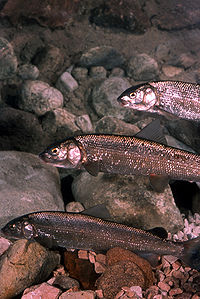
| Permits | Allowable Methods | Natives and Non-Native Species | Season and Hours |
|---|---|---|---|
|
|
|
|

